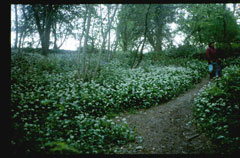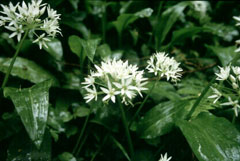 |
|
(c) 2010 Ken Fern, Plants For A Future |
 |
| (c) 2010 Ken Fern, Plants For A Future |
Translate this page:
Summary
Physical Characteristics

 Allium_ursinum is a BULB growing to 0.3 m (1ft) by 0.3 m (1ft in).
Allium_ursinum is a BULB growing to 0.3 m (1ft) by 0.3 m (1ft in).
See above for USDA hardiness. It is hardy to UK zone 5 and is not frost tender. It is in leaf from February to June, in flower from May to June, and the seeds ripen from May to July. The species is hermaphrodite (has both male and female organs) and is pollinated by Bees, insects.
Suitable for: light (sandy) and medium (loamy) soils. Suitable pH: mildly acid, neutral and basic (mildly alkaline) soils. It can grow in full shade (deep woodland) semi-shade (light woodland) or no shade. It prefers moist soil.
UK Hardiness Map
US Hardiness Map
Synonyms
Plant Habitats
Edible Uses
Leaves - raw or cooked[2, 5, 9, 12, 24]. Usually available from late January[K]. One report says that they have an overpowering garlic odour that dissipates on cooking[183], though our experience is that they are considerably milder than garlic[K]. The leaves make a very nice addition to salads, and are especially welcome as a vital and fresh green leaf in the middle of winter[K]. Flowers - raw or cooked. These are somewhat stronger than the leaves, in small quantities they make a decorative and very tasty addition to salads[K]. The flowering heads can still be eaten as the seed pods are forming, though the flavour gets even stronger as the seeds ripen[K]. Bulb - raw or cooked[2]. A fairly strong garlic flavour, though it is quite small and fiddly to harvest[K]. The bulbs can be harvested at any time the plant is dormant from early summer to early winter. Harvested in early summer, they will store for at least 6 months[K]. The bulbs can be up to 4cm long and 1cm in diameter[00]. The small green bulbils are used as a caper substitute[183].
References More on Edible Uses
Medicinal Uses
Plants For A Future can not take any responsibility for any adverse effects from the use of plants. Always seek advice from a professional before using a plant medicinally.
Ramsons has most of the health benefits of the cultivated garlic, A. sativum[7, 238], though it is weaker in action[254]. It is therefore a very beneficial addition to the diet, promoting the general health of the body when used regularly. It is particularly effective in reducing high blood pressure and blood cholesterol levels[9]. It is recognised as having a good effect on fermentative dyspepsia[244]. All parts of the plant can be used, but the bulb is most active. The plant is anthelmintic, antiasthmatic, anticholesterolemic, antiseptic, antispasmodic, astringent, cholagogue, depuritive, diaphoretic, diuretic, expectorant, febrifuge, hypotensive, rubefacient, stimulant, stomachic, tonic and vasodilator[7, 21]. Ramsons ease stomach pain and are tonic to the digestion, so they can be used in the treatment of diarrhoea, colic, wind, indigestion and loss of appetite[254]. The whole herb can be used in an infusion against threadworms, either ingested or given as an enema[254]. The herb is also beneficial in the treatment of asthma, bronchitis and emphysema[254]. The juice is used as an aid to weight loss and can also be applied externally to rheumatic and arthritic joints where its mild irritant action and stimulation to the local circulation can be of benefit[254].
References More on Medicinal Uses
The Bookshop: Edible Plant Books
Our Latest books on Perennial Plants For Food Forests and Permaculture Gardens in paperback or digital formats.

Edible Tropical Plants
Food Forest Plants for Hotter Conditions: 250+ Plants For Tropical Food Forests & Permaculture Gardens.
More

Edible Temperate Plants
Plants for Your Food Forest: 500 Plants for Temperate Food Forests & Permaculture Gardens.
More

More Books
PFAF have eight books available in paperback and digital formats. Browse the shop for more information.
Shop Now
Other Uses
The juice of the plant is used as a moth repellent. The whole plant is said to repel insects and moles[20]. The juice of the plant has been used as a general household disinfectant[7].
Special Uses
References More on Other Uses
Cultivation details
Prefers woodland conditions in a moist well-drained soil[203]. Plants are often found in the wild growing in quite wet situations[K]. When growing in suitable conditions, wild garlic forms a dense carpet of growth in the spring and can be a very invasive plant[24, 203, K]. It dies down in early summer, however, allowing other plants to grow in the same space[K]. The bulbs should be planted fairly deeply[1]. The seeds are dispersed by ants[244]. Grows well with most plants, especially roses, carrots, beet and chamomile, but it inhibits the growth of legumes[18, 20, 54]. This plant is a bad companion for alfalfa, each species negatively affecting the other[201]. Members of this genus are rarely if ever troubled by browsing deer[233].
References Carbon Farming Information and Carbon Sequestration Information
Temperature Converter
Type a value in the Celsius field to convert the value to Fahrenheit:
Fahrenheit:
The PFAF Bookshop
Plants For A Future have a number of books available in paperback and digital form. Book titles include Edible Plants, Edible Perennials, Edible Trees,Edible Shrubs, Woodland Gardening, and Temperate Food Forest Plants. Our new book is Food Forest Plants For Hotter Conditions (Tropical and Sub-Tropical).
Shop Now
Plant Propagation
Seed - best sown as soon as it is ripe either in situ or in a cold frame. It germinates quickly and can be grown on in the greenhouse for the first year, planting out the dormant bulbs in the late summer of the following year. Stored seed can be sown in spring in a greenhouse. Division in summer after the plants have died down. Very easy, the divisions can be planted out straight into their permanent positions.
Other Names
If available other names are mentioned here
Native Range
TEMPERATE ASIA: Turkey, Russian Federation-Ciscaucasia (Ciscaucasia), Armenia, Azerbaijan, Georgia EUROPE: Denmark, Finland, United Kingdom, Ireland, Norway, Sweden, Czechoslovakia, Austria, Belgium, Switzerland, Germany, Hungary, Netherlands, Poland, Ukraine, Former Yugoslavia, Bulgaria, Greece, Italy (incl. Sicily), Romania, Spain, France (incl. Corsica)
Weed Potential
Right plant wrong place. We are currently updating this section.
Please note that a plant may be invasive in one area but may not in your area so it’s worth checking.
Conservation Status
IUCN Red List of Threatened Plants Status :

Growth: S = slow M = medium F = fast. Soil: L = light (sandy) M = medium H = heavy (clay). pH: A = acid N = neutral B = basic (alkaline). Shade: F = full shade S = semi-shade N = no shade. Moisture: D = dry M = Moist We = wet Wa = water.
Expert comment
Author
L.
Botanical References
17200
Links / References
For a list of references used on this page please go here
Readers comment